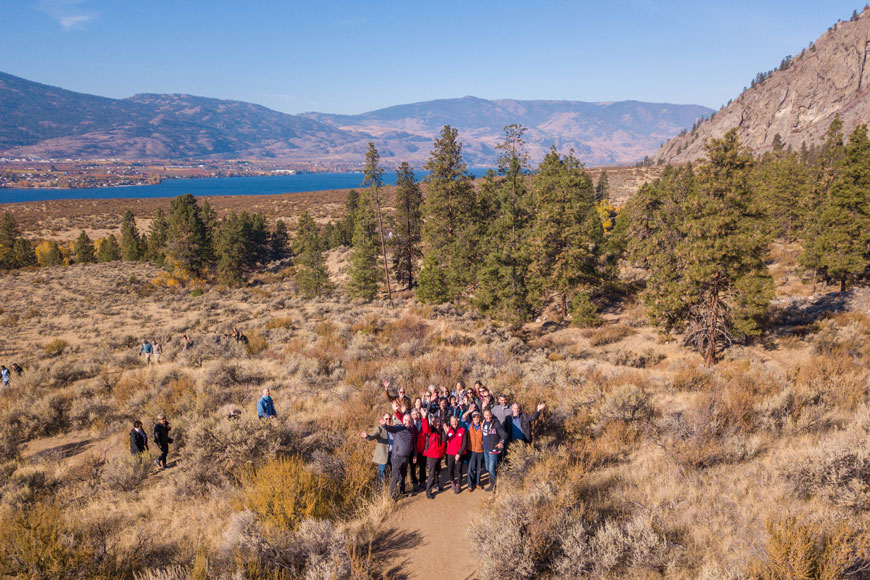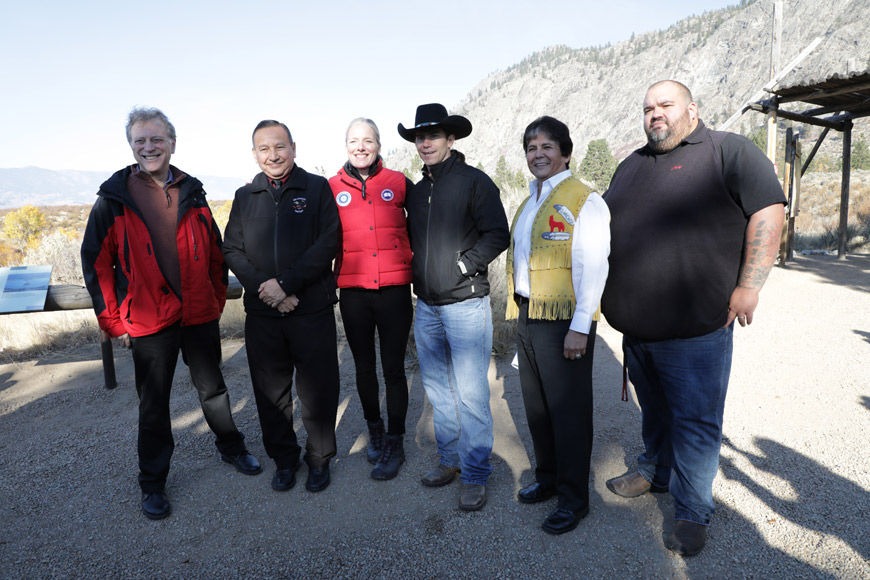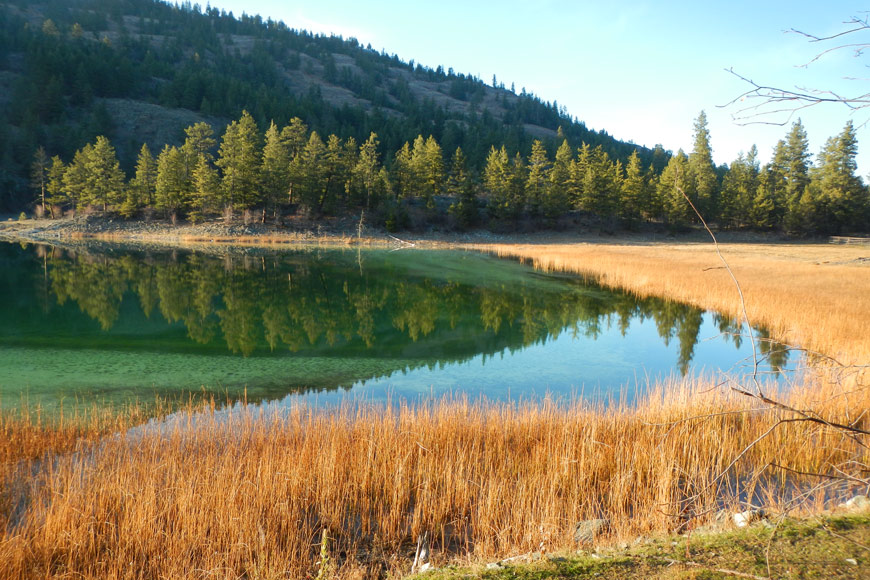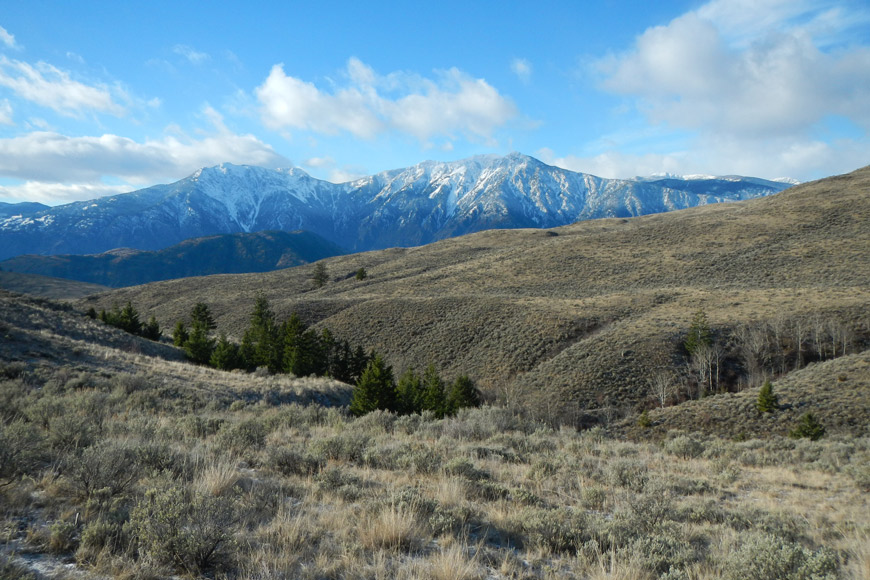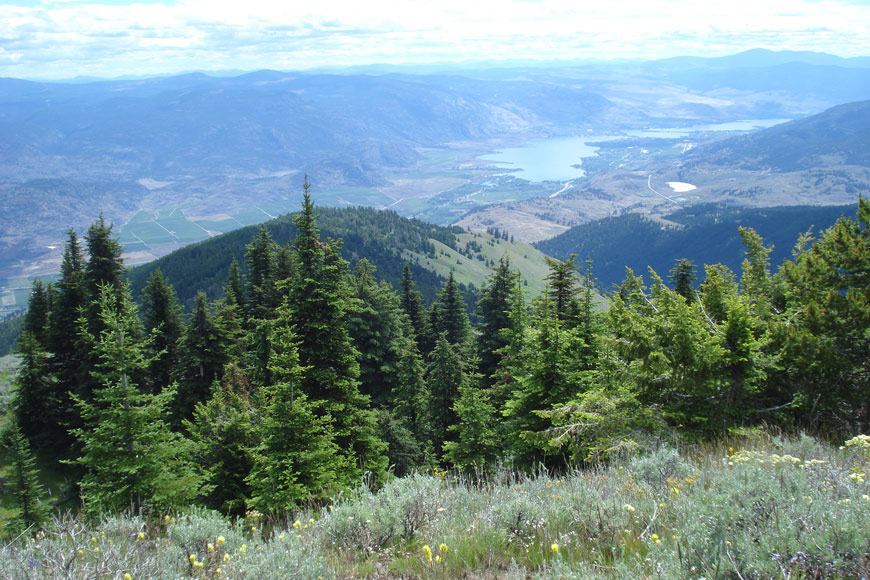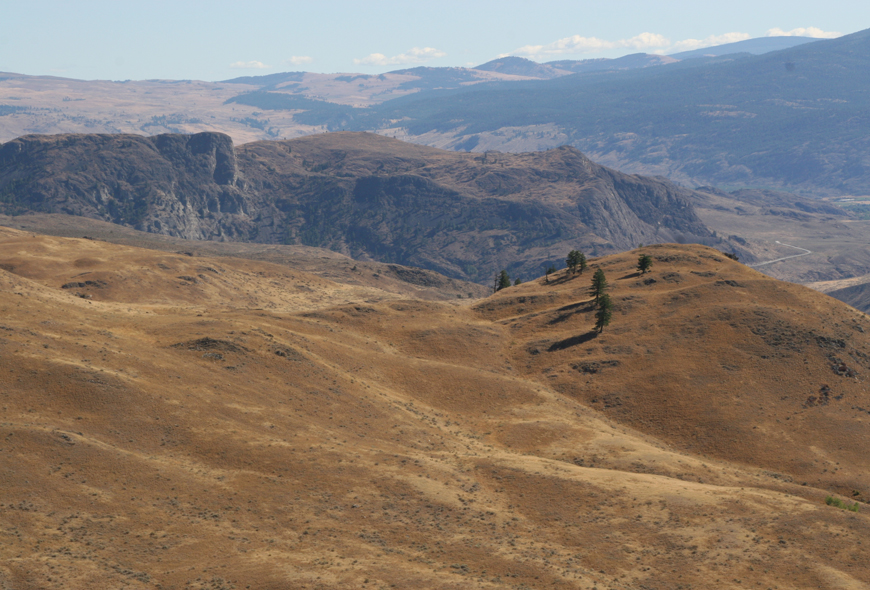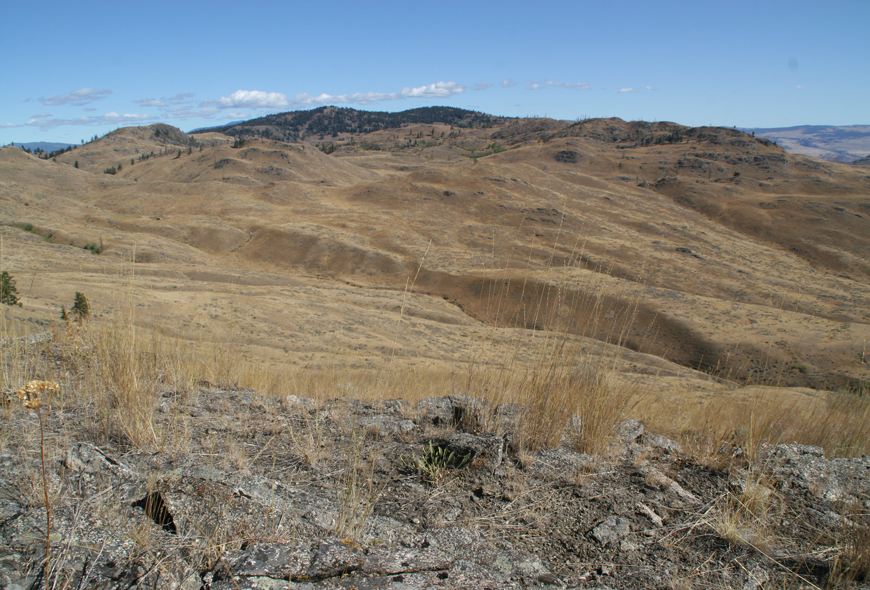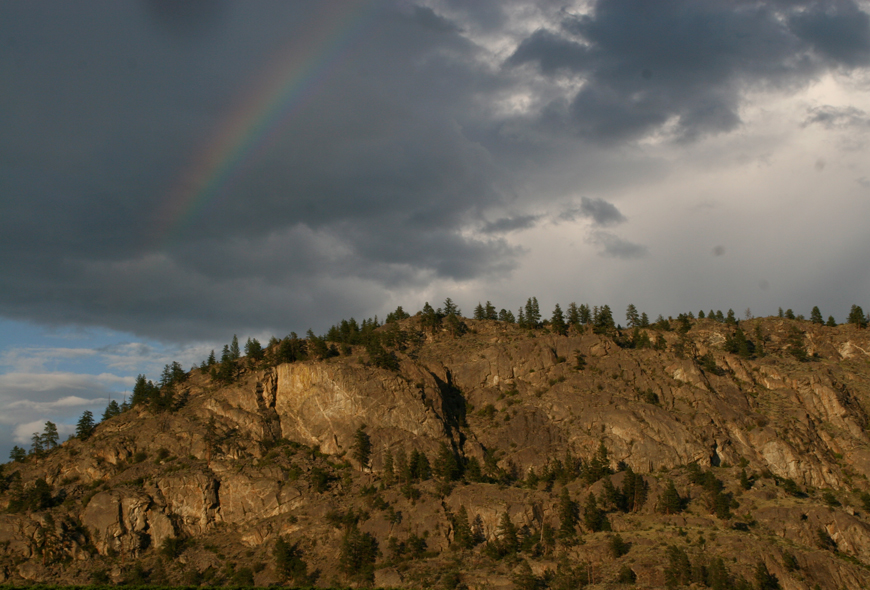
Blue Lake in the South of Kilpoola.
Province of B.C. (Ministry of Environment and Climate Change Strategy)
Proposed National Park Reserve in the South Okanagan-Similkameen
Memorandum of Understanding
On July 2nd, 2019, the governments of Canada and British Columbia and the syilx/Okanagan Nation signed a Memorandum of Understanding to formally work toward establishing a national park reserve in the South Okanagan-Similkameen. This is a significant step towards the establishment of a national park reserve in the South Okanagan-Similkameen.
The Memorandum of Understanding confirms the working boundary for the proposed national park reserve, outlines next steps and provides a framework of collaboration as negotiations begin for an establishment agreement. Working together, the governments of Canada and British Columbia and the syilx/Okanagan Nation are taking action to protect this iconic natural and cultural landscape for future generations.
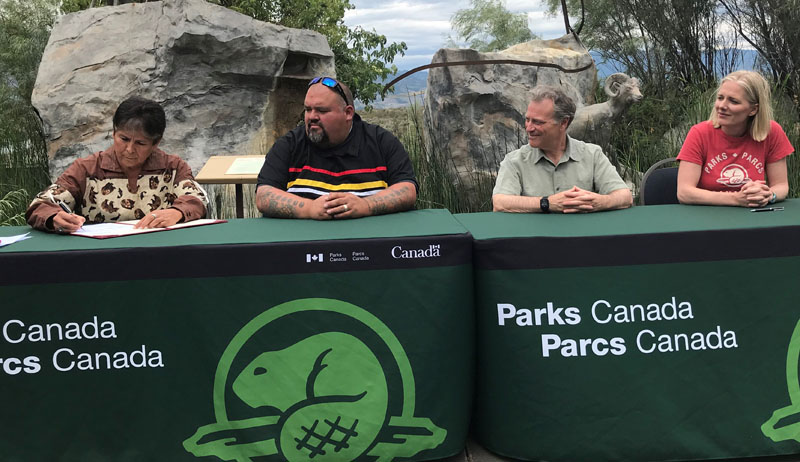
The working boundary of the proposed national park reserve includes 273 square kilometres of natural and cultural landscapes in the tx̌asqn (Mt Kobau), kɬlilxʷ (Spotted Lake), and nk̓lpulaxʷ (Kilpoola) areas of the iʔ nxʷəlxʷəltantət (South Okanagan – Similkameen) area, including BC Parks’ South Okanagan Grasslands Protected Area. Moving forward, the parties agree to support a consensus approach to decision making in the negotiation and the implementation of the national park reserve establishment agreement. The agreement will define the terms and conditions for the establishment, development, management and operation of a national park reserve.
Among other commitments, the Memorandum of Understanding responds to local concerns raised in the public consultation period and confirms that:
- Canada, British Columbia and the sməlqmix / suknaʔkinx (Okanagan Nation) as represented by the Lower Similkameen Indian Band and the Osoyoos Indian Band, will proceed to negotiate a formal national park reserve establishment agreement;
- Canada cannot and will not expropriate private property in order to establish or expand a national park or national park reserve;
- Residents will not have to pay a fee to access their homes/private property or to receive guests;
- All public highways will remain under the administration of the BC Ministry of Transportation and Infrastructure, and will not become toll roads.
Until the formal establishment of a national park reserve:
- Existing licences, leases and tenures will continue under existing provincial management policies, regulatory licensing processes, terms and conditions; and;
- The establishment agreement may also include provisions for the establishment of a local advisory committee to provide advice on park issues as they pertain to community matters.
A copy of the Memorandum of Understanding can be found on this website and at Let’s Talk South Okanagan Similkameen website.
Why here
The South Okanagan-Similkameen is where the northern edge of the Great Basin Desert reaches into British Columbia, in the extreme south of the Interior Dry Plateau natural region.
This is one of 39 regions identified by Parks Canada’s national parks system plan as a distinctive component of the national landscape, and is not yet represented by a national park. From both national and provincial perspectives, this is an area of high conservation value and an excellent candidate area for Parks Canada to represent this region.
The goals of establishing a national park are to:
- protect the diversity of vegetation and landscape features of representative ecosystems that define the Interior Dry Plateau natural region;
- maintain the ecological integrity of wildlife habitat and plant species; and
- provide opportunities for quality visitor experiences, such as recreational activities and the presentation of natural and cultural heritage.
About the region
Within rolling hills and sweeping valleys, the Okanagan is one of the most ecologically-diverse regions of Canada. The shrub steppe ecosystem found in the interior of British Columbia, including the South Okanagan-Similkameen, is recognized as one of the country’s most endangered natural systems. These rare pockets of semi-arid desert are the only occurrence of this ecosystem in Canada; they form the northern tip of North America’s Great Basin Desert. By establishing a national park reserve in the South Okanagan-Similkameen, Parks Canada will protect and represent this rare and endangered ecosystem in the national park system.
By protecting this area, we will help support the recovery of over 35 federally listed species at risk, and over 90 provincially listed species, including American badgers, flammulated owls, yellow breasted chat, desert night snakes, and western rattlesnakes.
It represents an area of significant ecological, geographic and cultural importance with a wide range of recreational and tourism opportunities like hiking, camping, bird watching and mountain biking.
The federal, provincial and syilx/Okanagan governments agree that the South Okanagan-Similkameen offers potential for the establishment of a national park reserve. National parks and national park reserves represent the very best that Canada has to offer and tell stories of who we are, including the history, cultures, and contributions of Indigenous peoples. The proposed national park reserve would enable the inspiring South Okanagan-Similkameen landscape to be shared with local residents, British Columbians, Canadians and visitors from around the world.
The natural and cultural values of the South Okanagan-Similkameen have sustained First Nations for thousands of years. A national park reserve is a unique opportunity for Parks Canada and First Nations to work together to achieve conservation and economic objectives.
Creating protected areas
The Government of Canada is committed to expanding our system of protected areas and protecting Canada’s biodiversity. Canada is committed to conserve at least 17 percent of our country’s land and freshwater and 10 percent of coastal and marine waters through a network of parks, protected and conserved areas, and other effective area-based conservation measures by 2020. As of August 1st, 2019, Canada has surpassed its marine conservation target to protect 10% of Canada’s marine and coastal areas.
National parks and national park reserves represent the very best that Canada has to offer and tell stories of who we are, including the history, cultures, and contributions of Indigenous peoples. Working together with First Nations, Inuit, and Métis groups across Canada, Parks Canada and Indigenous peoples are partners in conserving, restoring, and presenting Canada’s natural and cultural heritage.
Strong relationships with Indigenous partners are essential to Parks Canada’s work and contribute to the process of reconciliation between Indigenous peoples, the Government of Canada, and other Canadians, based on the recognition of rights, respect, co-operation, and partnership.
The creation of new protected areas provides an opportunity to advance strong relationships with Indigenous communities through new partnership models based on cooperative management.
The principal difference between a national park and a national park reserve is that the term “reserve” is used to recognize that there are unresolved claims of Aboriginal rights in the area. Indigenous peoples can continue to participate in traditional land uses and spiritual activities, and may be involved in cooperative management with Parks Canada.
Canada’s network of protected areas plays an important role in helping to mitigate the impacts of climate change by protecting and restoring healthy, resilient ecosystems and contributing to the recovery of species at risk. As climate change continues, many desert species will be pushed northward, and potentially upslope, into the shrub steppe ecosystem of the South Okanagan-Similkameen. It is increasingly important to take protective measures to safeguard this significant and diverse region in the B.C. interior as a national park reserve.
Parks Canada will work with the syilx/Okanagan, the Government of British Columbia, communities, conservation groups, private businesses, ranchers, and tourism and municipal organizations to conserve and protect the natural and cultural heritage of this special place, and to see this national park reserve become a reality to enjoy and use for generations to come.
Background
Work on creating a national park reserve in this region started in 2004 through the launch of a feasibility assessment, that included consultations, to determine if, and under what conditions, a national park reserve could be established in the South Okanagan-Similkameen.
It was concluded in 2011 by Parks Canada and the province of British Columbia, and in 2012 through a separate undertaking by First Nations, that a national park reserve was feasible under certain conditions. However, the proposal was not advanced any further until 2017.
A tripartite (joint government) announcement in October 2017 a renewed commitment to a collaborative approach between the Government of Canada, the Government of British Columbia and the syilx/Okanagan Nation to examine the establishment of a national park reserve in the South Okanagan-Similkameen.
Following the October 2017 announcement, the Government of Canada, the Government of British Columbia and the syilx/Okanagan Nation developed recommendations, including models for cooperative management, regarding the establishment of a national park reserve in the South Okanagan–Similkameen. The focus was on developing the proposed national park reserve concept, including a boundary, on which Parks Canada sought feedback during the public consultations between December 2018 and March 2019.
Parks Canada held 39 meetings with stakeholder groups representing 627 local stakeholders with a variety of interests, and received 2,848 survey submissions as part of the online consultations. In support of its commitment to transparency, Parks Canada has shared a summary of the results of the public consultations through a What We Heard report, which was developed by a third-party consultant, that can be found at Let’s Talk South Okanagan-Similkameen. The results of this report were shared in person at information sessions in May 2019 in the local communities of Oliver, Osoyoos, Keremeos and Penticton.
In July 2019, the governments of Canada and British Columbia and the syilx/Okanagan Nation signed a Memorandum of Understanding to formally work toward establishing a national park reserve in the South Okanagan-Similkameen.
What it means to establish a national park reserve
Parks Canada is committed to working collaboratively on the establishment and management of a new national park reserve. When established, a new national park reserve in the South Okanagan-Similkameen would protect and represent one of the most southern and endangered natural regions in Canada and enable this inspiring landscape to be shared with Canadians and visitors from around the world. Parks Canada’s commitment to providing long-term, on-going funding and protection will bring benefits to this area.
The proposed national park reserve would create benefits in the following areas:
Conservation
- conserving one of Canada’s most unique habitats that has sustained syilx/Okanagan communities for thousands of years;
- helping to protect and conserve over 35 federally-listed and over 90 provincially listed species at risk and their habitats;
- providing a level of resilience to this significant and diverse region of our country facing climate change;
- reducing the risk of wildfires and protecting visitors, infrastructure, and natural and cultural resources of the lands through Parks Canada’s fire management program;
- allowing activities within the proposed national park reserve to be managed in a more ecological and regenerative manner.
Relationships
- advancing strong relationships with Indigenous and local communities through new partnership models for cooperative management of the proposed national park reserve;
- helping preserve the way of life of the syilx/Okanagan people through the continuation of Indigenous relationships with the land, including traditional land uses and spiritual activities.
Economic opportunities
- providing opportunities for local residents and visitors to continue to experience and appreciate this environment;
- strategically boosting domestic and international tourism in an ecologically sensitive manner; and,
- encouraging ecologically sustainable economic opportunities in the region.
Timeline
- 2019
- The governments of Canada and British Columbia and the syilx/Okanagan Nation signed a Memorandum of Understanding to formally work toward establishing a national park reserve in the South Okanagan-Similkameen under a revised Park Concept. The working boundary of the proposed national park reserve now includes 273 square kilometres of natural and cultural landscapes.
- 2018
- Parks Canada launched consultations on a proposed national park concept, including a boundary. Parks Canada held 39 meetings with stakeholder groups representing 627 local stakeholders with a variety of interests, and received 2,848 survey submissions as part of the online consultations.
- 2017
- As announced in October 2017, the governments of Canada and British Columbia, along with the syilx/Okanagan Nation, share a renewed commitment to work together to establish a new national park reserve in the South Okanagan.
- 2012
- In December, the Okanagan Nation completed a feasibility assessment for establishing a syilx/Parks Canada national park reserve, recommending that the Okanagan Nation Alliance continue to work with Parks Canada and British Columbia on the proposed park reserve. As a result of the 2011 provincial decision, further work on the proposal ceased.
- 2011
- In January, the Canada – British Columbia Steering Committee concluded that a 284 square kilometres national park reserve was feasible and recommended that work continue with the Okanagan First Nations. However, the Government of British Columbia determined that it was not ready to proceed with a park reserve in this area at that time.
- 2010
- A revised 2010 Park Concept was developed with a more collective vision and approach, including a smaller park concept with a revised boundary of approximately 284 square kilometres. It focused on protection of the lower elevation grasslands where species diversity is highest and most at risk. It excluded large areas that were used for helicopter training, sport hunting and ATV use.
The 2010 Park Concept represented a significant departure from the earlier, larger draft concept. The changes to the size of the area, the adoption of an adaptive management framework for grazing, and positive steps towards re-engagement with the Okanagan Nation Alliance and local bands were an outcome of dialogue and consultation. - 2006
- The second phase of broad consultations took place to examine a park concept including mapped boundaries. Over 1800 people attended open houses, and hundreds more filled in comment forms and/or emailed the project manager.
A draft park concept of 650 square kilometres and comprised of three components was presented and feedback was gathered from community open houses, forums, workshops, and meetings. This assisted Parks Canada in better understanding where common interests from First Nations, communities, the public, and stakeholders could be combined to build a common vision. Concerns and opportunities were used to refine the first draft park concept, and later, the modified 2010 Park Concept. - 2004
- The assessment to determine the feasibility of a national park reserve in the South Okanagan was launched by the governments of Canada and British Columbia. The first phase of broad consultations took place, defining the scope of issues and opportunities.
- 2003
- The governments of Canada and British Columbia signed a Memorandum of Understanding for the purpose of advancing several Parks Canada initiatives with the province, including an assessment of the feasibility of establishing a national park reserve in the South Okanagan-Similkameen.
Next steps
The next step in the process is negotiating a formal national park reserve establishment agreement that will define the terms and conditions for the establishment, development, management and operation of the national park reserve.
Learn more
- National park reserve in the South Okanagan-Similkameen moves forward
- What We Heard summary report
- Public consultation: December 10, 2018 - February 28, 2019
- Working Together to Establish a National Park Reserve in the South Okanagan-Similkameen
- 2011 Feasibility Report summary
- Canada’s National Parks System Plan
- Canada National Parks Act
FAQs
A Tripartite (joint government) announcement in October 2017 renewed commitment to a collaborative approach between the Government of Canada, the Government of British Columbia and the syilx/Okanagan Nation to examine the establishment of a national park reserve in the South Okanagan-Similkameen.
The focus was on developing the proposed national park reserve concept, including a boundary, on which Parks Canada sought feedback during the public consultations from December 10, 2018 to March 15, 2019.
The establishment of a national park reserve in the South Okanagan-Similkameen represents a valuable opportunity to advance reconciliation and for nation-to-nation engagement with the syilx/Okanagan Nation leading to a new partnership model for management of the proposed national park reserve. These discussions also take into consideration the continuation of ranching and recreational activities in the region.
Parks Canada recognizes that the process has been lengthy and that uncertainty around the proposed national park reserve in the South Okanagan-Similkameen has been difficult.
Parks Canada has listened to and learned a great deal from First Nations, provincial agencies, communities, ranchers, and other stakeholders. A national park reserve in this area would be unique and would require innovative approaches that respect and celebrate Indigenous values and traditions, ranching culture, local communities, and the rich biodiversity and ecosystems that make this region so special.
It is important that the public continues to be provided with an opportunity for input regarding the national park reserve in the South Okanagan-Similkameen and that time is taken to develop workable solutions.
The public was consulted on a revised national park reserve concept and key aspects of land use management with the proposed national park reserve from December 10, 2018, to March 15, 2019. Consultations on the proposed park concept and boundary have concluded.
The purpose of these questions and answers is to provide a common base of information to respond to questions being raised by the public following the July 2, 2019 announcement for the signing of the MOU.
Who within the federal government is responsible for the South Okanagan-Similkameen national park reserve establishment process?
Parks Canada is the lead federal agency responsible for the park establishment process. Other federal agencies in the area include Environment and Climate Change Canada’s Canadian Wildlife Service (CWS) and Natural Resources Canada Dominion Radio Atmospheric Observatory.
Is a new feasibility assessment needed, or will the governments approve the previous version?
The Canada-B.C. Steering Committee completed a feasibility assessment report in 2011 that was not approved by the Government of British Columbia at that time.
The Syilx/Okanagan Nation also completed a Syilx vision for a protected area and associated recommendations in 2012.
Parks Canada, the Government of British Columbia, and the Syilx/Okanagan Nation will develop a revised park reserve concept and proposed boundary and will consult with the public on this park concept, The Lower Similkameen and Osoyoos Indian bands will establish information sharing and consultation processes for their respective Communities. The information gathered in support of the previous feasibility assessment reports will assist the parties in finalizing a national park reserve concept. As such, a new feasibility assessment is not required.
How will a national park reserve impact local residents?
Parks Canada does not include communities within the boundaries of new national parks or national park reserves. As such, area residents will not have to pay a fee to access their homes or to receive guests. Local residents will be able to continue to access the backcountry within the park reserve as long as the activities are permitted under the Canada National Parks Act and there are no public safety or resource protection concerns.
Canada's national parks belong to all Canadians. National parks and national park reserves enable Canadians, including youth and newcomers, to experience the outdoors and learn about our environment.
Did you know?
The term “reserve” used under the Canada National Parks Act is being used to recognize that there are unresolved claims of Aboriginal rights in the area. In addition, within a national park reserve, Indigenous peoples can continue to participate in traditional land uses and spiritual activities, and may be involved in cooperative management with Parks Canada.
Will there be an impact to private lands?
The federal government has no jurisdiction over property rights on privately owned land adjacent to the boundaries of a national park. Land owners and communities adjacent to the proposed national park reserve will retain full authority over their lands.
Furthermore, lands within the national park reserve would only ever be acquired by mutual agreement (willing seller – willing buyer basis). As set out in the Canada National Parks Act, Section 15 (6), the Government of Canada cannot expropriate private property in order to enlarge or establish a national park or national park reserve. Private lands would only ever be purchased on a willing seller-willing buyer basis, based upon independent property appraisals.
Will cattle grazing be allowed?
Throughout the feasibility assessment process leading to the 2010 park concept for a national park reserve in the South Okanagan-Similkameen, Parks Canada has recognized the importance of strong relationships with ranchers and the local ranching industry.
As we move forward in determining the boundaries of the national park reserve proposal, Parks Canada is committed to working with ranching families and the local livestock association to use a regulatory framework that provides ranching families with stability and certainty on crown grazing lands, tenures, water, and other resource values within the proposed national park reserve.
Long term relationships with ranchers are critical to the future success of a national park reserve in the South Okanagan-Lower Similkameen. Although commercial livestock grazing is not typically allowed in a national park reserve, Parks Canada is committed to working with ranching families to provide certainty and stability on their respective Crown grazing tenures. Ranching families within the proposed national park reserve will be able to continue operating as they are today with a similar regulatory framework. A transition plan between the Government of British Columbia and the national park reserve is currently under development.
How will fires be managed?
Syilx peoples have managed the landscape through controlled burns for millenia. Parks Canada is a leader with more than 30 years of experience in fire management and using fire to naturally restore and maintain the ecological integrity of national parks. Parks Canada also manages fire and fuel sources to protect important resources and infrastructure and to prevent catastrophic wildfire.
A fire management plan and a vegetation management plan will be developed for the proposed national park reserve.
Parks Canada will engage with communities, neighbouring jurisdictions, and the public in a dialogue about the objectives and techniques of wildfire control and fire use.
Through its national fire management program, Parks Canada is committed to reducing the risk of wildfires to park and adjacent lands, and to protecting visitors, infrastructure, and natural and cultural resources on the lands it manages. Extensive planning will help manage and reduce the risk of wildfire in the forests and grasslands of the proposed park, in the boundary areas between the park and communities, and on adjacent lands.
Joint planning, public education, active fire management, and training sessions will provide an opportunity to both prevent as well as quickly respond to wildfire incidents.
The safety of the public, fire crews, park infrastructure, and neighbouring lands is always Parks Canada’s number one priority. When wildfires occur and present a risk to people, property, cultural or ecological values, Parks Canada coordinates its efforts with provincial governments, local communities, and other partners to respond immediately to fully suppress wildfires.
Will a national park reserve allow access for continued helicopter use and training?
Parks Canada stands by the commitment to respect provincial permits for helicopter access and training within the proposed park made during previous discussions on a national park reserve proposal in the South Okanagan-Similkameen. Currently and until the time where the national park reserve is established, the permitting of local helicopter operations in the area is the responsibility of Government of British Columbia.
Will area residents have to pay a fee to access their homes by road or to receive guests?
Area residents will not have to pay a fee to access their homes or to receive guests. Parks Canada does not include communities within new national park reserves.
When the national park is established, will Highway 3 become a toll highway?
Even though Highway 3 may traverse the national park reserve, it will not become a toll highway. All main highways will remain under the care and maintenance of the British Columbia Ministry of Transportation and Infrastructure, and fees will not be charged.
Will local residents no longer be able to access the back country because they will either be prohibited, or there will be fees attached?
Local residents will be able to continue to access the backcountry as long as the activities are permitted under the Canada National Parks Act and there are no public safety or resource protection concerns. Fees may apply to recover costs to maintain certain visitor facilities such as backcountry campsites.
Parks Canada charges fees for services and facilities that provide a personal benefit to users. All revenues from fees at national parks, national historic sites, and national marine conservation areas are reinvested at the location where they are collected in new services and products and are used for such purposes as maintenance, repairs, or replacement of aging visitor facilities, as well as to enhance visitor experiences. Prices are set to ensure a good value to visitors as well as a fair economic return for taxpayers based on market value and rates.
Canada's national parks belong to all Canadians. We want people to come to national parks to learn about them, to experience them, and to appreciate them.
How does Parks Canada enforce laws under the Canada National Parks Act once a new national park or national park reserve has been created?
When a national park or national park reserve is created, the Canada National Parks Act and a number of other federal laws and regulations come into force to legally protect the natural and cultural resources, including species at risk and other wildlife. Parks Canada's approach to ensure these laws are successful is first through education, outreach, and prevention strategies. The vast majority of visitors are willing to follow all regulations once they are aware of them. Ultimately, when people do break the law, park wardens will assess the situation and take appropriate law enforcement action. By combining education, prevention measures, and law enforcement actions, we are confident that we can continue to protect the natural and cultural resources within national parks, and to ensure enjoyable visitor experiences.
- Date modified :
